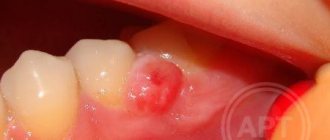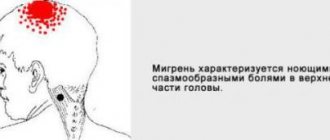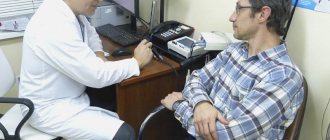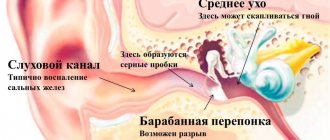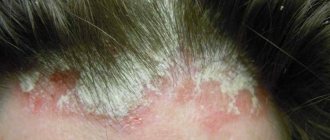Classification of noise in the head and ears
Due to the variety of noise variants, they were classified - combined into groups, common according to the causes of occurrence or characteristics of the course of the disease.
EPFowler (1947) identified two types of tinnitus:
- objective, or vibrator (occurs as a result of vibrations of any parts of the body, exists in reality, can be recorded using a phonendoscope or the use of other diagnostic methods);
- subjective, or non-vibratory (felt by a person, but does not occur in reality, the source of the hum in real life is absent; it cannot be assessed from the outside; it is also called the term “tinnitus”).
In their practice, doctors use a classification of noise based on its cause and distinguish:
- noise of the external, middle ear;
- muscular;
- vascular;
- central;
- peripheral noise.
Shpidonov Gennady Stanislavovich
Neurologist
Rostov State Medical University (neurology)
10 years of experience
Depending on the quality characteristics, the following are distinguished:
- one-sided or two-sided;
- pulsating or monotonous;
- arising from time to time or present constantly;
- low-frequency hum or high-frequency squeak, ringing;
- barely noticeable or strong, intense noise.
Causes
Noises in a person’s head are not always a symptom of pathology. Many sounds arise in our body during its life - during blood flow, joint movement, contraction and relaxation of muscles. They are masked by other sounds present around us and seem invisible to us, and in conditions of complete silence we can pay attention to them.
However, in most situations, extraneous noise, humming and other sounds in the head or ears are a sign of a pathological condition and a reason to contact a specialist.
Vibrator noise is caused by:
- diseases of the temporomandibular joint;
- neuromuscular diseases (gap of the auditory tube, myoclonus of the muscles of the soft palate, middle ear);
- changes in blood vessels (heart valve defects, narrowing of arteries, problems with veins, arteriovenous shunts).
Subjective noise may be based on:
- metabolic disorders (diabetes mellitus, thyrotoxicosis, hyperglycemia, hypoglycemia, atherosclerosis);
- brain tumors;
- neuroma of the VIII pair of cranial nerves;
- diseases of the hearing organ (cerumen plug, otitis, sensorineural hearing loss, labyrinthitis, neoplasms, Meniere's disease, trauma);
- damage by toxic substances (medicines that have a toxic effect on the organ of hearing, methyl alcohol and others);
- diseases of the spine (degenerative-dystrophic changes, instability and others);
- neurological diseases (acute and chronic cerebrovascular accidents, multiple sclerosis, neurocirculatory (vegetative-vascular) dystonia);
- hypertonic disease;
- mental disorders (neurasthenia and other neurotic disorders, depression, schizophrenia);
- exposure to noise and vibration in production;
- traumatic brain injuries (bruises, contusions).
Shpidonov Gennady Stanislavovich
Neurologist
Rostov State Medical University (neurology)
10 years of experience
How is a noise in the head diagnosed after a head impact?
If there is a history of recent TBI, then this is the main possible cause of noise in the head. The doctor conducts a physical examination, studies the patient’s complaints, conducts neurological testing: checks reflexes, identifies motor and speech disorders.
With mild concussions and bruises, patients often do not seek medical help, which is why the consequences of TBI are delayed.
The doctor must prescribe an additional instrumental examination, which includes the following diagnostic methods:
- Radiography. Shows the integrity of the skull bones. It is performed in two projections: direct and lateral.
- Computed tomography (CT). Informative regarding skull fractures, brain contusions, hematomas.
- Magnetic resonance imaging (MRI). Allows you to identify swelling of soft tissues, areas of hemorrhage, structural changes, and determine the dislocation of the cerebral hemispheres. It is carried out to diagnose post-traumatic complications, which include frequent headaches and noise in the head, and is the most informative method. You can get an MRI at the SmartMed clinic, where a new MRI scanner is installed. The examination has a high degree of accuracy, so you can reliably determine the cause of noise in the head.
- Angiography of cerebral vessels. Allows you to identify all vascular disorders that can cause noise and headaches.
- Encephalography. Designed to assess the functional activity of the brain in order to identify functional disorders that arose after TBI.
Based on the examination results, the doctor determines the cause of the headache and ringing.
Since the appearance of these symptoms may be associated not only with damage to blood vessels or nervous tissue, increased intracranial pressure, but also with stress and a depressive state after a TBI, you should visit a psychologist or psychotherapist.
Rumble in my head
It can also be normal if it appears when a person is in a noisy environment (on a street with active traffic, in a crowded place, in a noisy industry) and after returning to a quiet place, it gradually goes away within two hours. Sometimes it appears as a side effect of a number of medications - antidepressants, anticancer drugs, some antibiotics and NSAIDs. It can also occur in the postoperative period during operations on the organ of hearing - in this situation it is a consequence of intervention in the apparatus that conducts sounds, and after a while it goes away on its own.
Diagnosis and treatment of noise in the head
When this unpleasant symptom appears, you should not waste time doing self-diagnosis, try to cope with it yourself, or hope that “it will pass.” The correct decision for the patient is to seek help from a specialist.
Diagnosis of diseases accompanied by noise in the head is carried out by doctors of various profiles - therapists, otolaryngologists, neurologists, psychotherapists/psychiatrists. But most often, patients with such a problem turn first to a neurologist.
First of all, the doctor’s task is to specify the noise, to understand what exactly the patient feels - a high-frequency squeak, ringing, buzzing, buzzing or hum, one- or two-sided, accompanied by pulsation or not; clarify the intensity of sensations and the symptoms that could accompany them. If the patient does not tell him himself, the doctor will ask leading questions about whether there is hearing loss, congestion in the ears, headache (usually occipital) pain, a tendency to increase or decrease blood pressure, find out what somatic diseases the person seeking his appointment suffers from. Human. Based on these data, the specialist will suggest what type of tinnitus he is dealing with - objective or subjective. Then he will conduct an objective examination - examine the organ of hearing and perform a number of tests necessary to make a diagnosis.
Shpidonov Gennady Stanislavovich
Neurologist
Rostov State Medical University (neurology)
10 years of experience
At the end of this diagnostic stage, the neurologist will make a preliminary diagnosis (or several putative diagnoses) and prescribe further examination to clarify it, in particular:
- general blood and urine analysis;
- blood biochemistry (lipidogram, coagulogram, ferritin);
- duplex or triplex scanning of neck vessels;
- MRI of the brain or cervical spine;
- consultation with an ENT doctor.
The scope of examinations is determined individually, depending on the specific clinical situation.
If a somatic doctor has not established the cause of noise in the head, he will assume the psychogenic nature of this condition and recommend that the patient consult a psychiatrist or psychotherapist. The specialist will have a targeted conversation with the patient, find out what complaints he has, focusing on feelings of anxiety or fear, decreased mood, especially in the morning, sleep disturbances, severe weakness, palpitations, sudden fluctuations in blood pressure, and will clarify whether this condition is permanent or temporary, not Is it related to stress? If a patient is suspected of neurosis, psychosomatic disorder or depression, the doctor will conduct a series of tests to clarify the diagnosis.
Only after the diagnosis has been established is it recommended to begin treatment for noise in the ear and head.
Medicines for noise in the head and ears
Conservative therapy often helps to cope with this symptom. Depending on the manifestation of which disease the noise is, the patient may be prescribed medications from the following groups:
- antibacterial, anti-inflammatory drugs (for infectious and inflammatory diseases of the ear);
- vascular drugs (improve blood circulation, nutrition of brain cells, dilate blood vessels);
- nootropics (improves metabolic processes in the cells of the nervous system);
- B vitamins (improve trophism of nervous tissue);
- trimetazidine (nourishes the heart muscle);
- iron supplements (if the noise is based on iron deficiency anemia);
- betahistine (for noise due to increased pressure in the cochlear labyrinth);
- antidepressants, anti-anxiety drugs, antipsychotics (if the pathology is psychogenic);
- sedatives, hypnotics – if the patient complains, it is not the inability to sleep;
- medications containing caffeine (for a tendency to low blood pressure, severe weakness and other symptoms of asthenia).
If the cause of the disease is cerumen, the doctor will wash it out of the ear and the noise will disappear.
Surgery
With confirmed damage to the autonomic nervous system, non-vibratory tinnitus can be eliminated by surgical intervention in the area of the nerves of the tympanic cavity or cervical sympathetic nodes.
Surgery on damaged structures of the tympanic cavity or cochlea will help get rid of objective noise.
Other treatment methods
As auxiliary methods of therapy, the patient may be prescribed:
- wearing a hearing aid, electrical stimulation of the auditory nerve (with decreased hearing acuity);
- physical therapy;
- massage;
- physiotherapy;
- psychotherapy.
Causes of heaviness in the head
Physiological factors
The most common causes of heaviness in the head are fatigue and lack of sleep.
Your eyes get stuck together, you want to quickly put your head on the pillow and fall asleep - this situation is typical for overwork. Symptoms that develop periodically after exercise usually do not pose a threat to a person. After a good sleep, the discomfort disappears. When such violations bother you too often, you should pay attention to your health status. Heaviness in the head occurs in many people under the influence of sea motion. Seasickness is diagnosed in every third adult and is manifested by dizziness, a feeling of “fog in the head,” and nausea. In most cases, symptoms are mild and can be managed without medication. Heaviness with pressing pain in the head also occurs with motion sickness in land transport.
Tension headache
This type of cephalalgia is sometimes manifested not by classic pressing or squeezing pain, but by heaviness in the head. The symptom occurs some time after waking up and may disappear after a few hours or last the whole day. Unpleasant symptoms are of moderate intensity and are not combined with acute pain or dizziness. In strength and character, the heaviness is similar to the feeling of a hoop squeezing the head.
Arterial hypertension
With high blood pressure, heaviness is observed in the occipital area of the head, which is aggravated in a lying position, when bending over, or straining. Discomfort becomes more noticeable during physical activity and stress. If the patient does not follow the recommendations for taking medications, does not control blood pressure, heaviness in the head bothers him every day. The spread of discomfort to the frontal area and the appearance of sharp pain is a sign of an incipient hypertensive crisis.
Heaviness in the head
Infectious processes
Most bacterial or viral infections in the prodromal period are manifested by low-grade body temperature, which provokes heaviness in the head. Symptoms are complemented by moderate pain in the joints and muscles, and drowsiness. Patients describe their condition as malaise or weakness. After 1-2 days, when the full picture of the disease unfolds, the severity is often replaced by classic cephalgia.
ENT diseases
The appearance of heaviness in the head during inflammatory otolaryngological pathologies is caused by general intoxication and malaise, accompanied by an increase in temperature. The symptom can occur with more serious damage to the organ of hearing, which is due to the spread of the process to the vestibular analyzer. Severity is usually accompanied by dizziness, nausea, and lack of coordination. The main ENT causes of discomfort:
- Sinusitis.
Heaviness in the frontal zone is observed with frontal sinusitis or ethmoiditis, which is associated with the accumulation of inflammatory exudate in the paranasal sinuses. Symptoms intensify when the head is tilted forward and pressure is applied to the bridge of the nose. The patient is also concerned about nasal congestion, mucopurulent discharge, and fever. - Eustachite.
Heaviness in the head in those suffering from inflammation of the auditory tube is due to the involvement of the structures of the middle ear in the process. In addition to this symptom, the patient complains of noise and ringing in the ears, and notices hearing loss. A pathognomonic sign of eustachitis is a feeling of resonance of one’s own voice. - Meniere's disease.
The disease is characterized by paroxysmal heaviness in the head, occurring simultaneously with dizziness and episodic unilateral loss of hearing. The patient experiences a feeling of rotation of surrounding objects or a feeling of “sinking” of his own body.
Pathologies of the cervical spine
Damage to the vertebrae or neurovascular structures located in this area is a typical cause of heaviness in the head in middle and older age. Symptoms appear against the background of osteochondrosis and cervical spondyloarthrosis. Patients complain of heaviness and dull pain in the head, which is accompanied by pain in the back of the neck. When making sharp turns or staying in an uncomfortable position for a long time, the pain becomes shooting, burning.
Paroxysmal heaviness in the back of the head, headaches and impaired coordination of movements develop with vertebral artery syndrome, which occurs as a basilar migraine. Occasionally, heaviness in the head is caused by congenital structural anomalies - Klippel-Feil syndrome, platybasia, basilar impression. In this case, symptoms mainly manifest in childhood.
Neurasthenia
A painful heaviness in the head that begins at the end of the day is a characteristic manifestation of asthenic neurosis. Patients experience an unpleasant feeling of pressure on the head from all sides, as if they were wearing a heavy and tight helmet. The clinical picture is complemented by dizziness. Its peculiarity is that surrounding objects seem motionless to a person, and rotation occurs “inside the head.”
In addition to physical symptoms, emotional disturbances are noted. Patients are characterized by increased nervousness, irritability and excitability. They react negatively to extraneous noise, loud speech, and large crowds of people. The patient feels that being around strangers makes the heaviness in his head intensify. Characterized by difficulty falling asleep, frequent awakenings at night and disturbing dreams.
Rare causes
- Withdrawal syndrome:
after using drugs, alcohol. - Intoxication
: heavy metals, organic solvents. - Polycythemia.
- Injuries
: concussion or contusion of the brain, subcutaneous hematoma in the scalp.
How to relieve an attack of severe noise in the head and ears
Treatment for severe head noise depends on its cause. If it occurs suddenly, is intense, is accompanied by vomiting, severe pain, heaviness in the head, dizziness, significantly worsens the person’s condition, and it is dangerous to fight it on your own - it is important to call an ambulance as quickly as possible.
Shpidonov Gennady Stanislavovich
Neurologist
Rostov State Medical University (neurology)
10 years of experience
If it is a sign of chronic pathology, is already familiar to you, and is not the first time it has appeared, you can try to cope with the noise using the following self-help methods:
- taking a relaxing bath;
- a full eight-hour sleep (on a comfortable mattress with a comfortable pillow, in a dark room, in silence);
- physical activity (such as yoga or jogging in the park);
- listening to calm music.
Some people are helped to eliminate noise by so-called “masking” - listening to a pleasant, soothing sound (such as the splashing of waves, the murmur of a stream, the chirping of birds) directly in nature, using an audio recording or a special device.
Treatment
Help before diagnosis
To eliminate heaviness in the head, a positive emotional attitude is of great importance. It is necessary to protect yourself as much as possible from stress and external irritants, normalize your daily routine, and not overwork yourself at work. Doctors advise establishing a drinking regime and limiting coffee consumption to 1 cup per day. Regular walking before bedtime, fortified meals, and a change of environment help reduce signs of neurasthenia.
Self-administration of painkillers to relieve heaviness and pain in the head is the wrong approach, since the symptoms manifest themselves in dozens of different diseases. Trying to eliminate discomfort, the patient does not solve the problem, so there is a risk of disease progression and complications. If heaviness in the head is accompanied by nausea and vomiting, visual and hearing impairment, this is an indication for emergency medical attention.
Conservative therapy
To eliminate heaviness in the head associated with tension cephalgia or neurasthenia, psychotropic medications are recommended. Antidepressants - selective serotonin and norepinephrine reuptake inhibitors - have a good effect. Additionally, muscle relaxants and sedatives are prescribed. To remove symptoms, restorative treatment is carried out with calcium glycerophosphate and hopantenic acid.
If the cervical spine is affected, tablets of non-steroidal anti-inflammatory drugs are taken, injections of chondroprotectors and B vitamins are given. To quickly relieve discomfort, ointments with an analgesic and warming effect are indicated. If the pathology is accompanied by vertebral artery syndrome, therapy is enhanced with neuroprotective drugs and medications that improve cerebral circulation.
For neurasthenic cephalgia and heaviness in the head, physiotherapeutic treatment is effective. Reflexology, aromatherapy, and electrosleep are effective in normalizing the functioning of the nervous system. To get rid of symptoms of cervical osteochondrosis, electrophoresis with drugs, magnetic therapy and electroanalgesia are used. ShVZ massage and manual therapy are performed strictly as prescribed by the doctor.
Prevention of pulsating noise in the head
The noise that occurs in the pulse rhythm is characteristic of vascular pathology of the brain. It can be prevented by a person’s attentive attitude to his health throughout his life - quitting smoking, regular exercise, adherence to a work and rest schedule, a nutritious, balanced diet, blood pressure control, timely medical examinations and treatment of vascular diseases that have arisen in the early stages. If these diseases already exist, following the recommendations described above will help reduce the intensity of the hum, alleviate it, which will improve the person’s quality of life.
If pulsating noise appears in the head only in certain situations (under stress, when working at the computer), its prevention will be to minimize exposure to situations that provoke deterioration of the condition.

